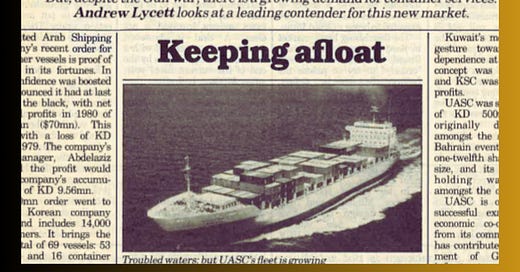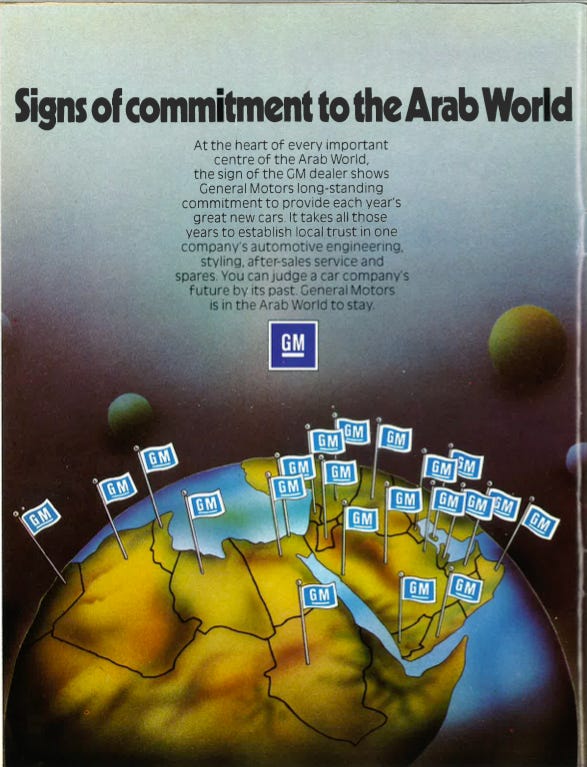The United Arab Shipping Company
Once described as a pan-Arab shipping line, UASC was established in 1976 by Saudi Arabia, Iraq, Kuwait, Bahrain, Qatar, and the United Arab Emirates.

Hello there, Noam here.
Before I discuss the shipping industry in the Arab gulf region, I want to share raw thoughts.
Lately I have been thinking about what happens to a person’s mind when they can no longer recognize their country, and even the region they were born in. This feeling of being chopped off from the source of one’s initial “identity” is incredible – it stupefies the mind. It’s indiscernible— this feeling— unless you recognize and sit with it. It’s heavy when the source of this remoteness is a failed and destructive leadership that speaks in your name. You can call it grief. Some become ensnared in pointless nostalgia - this exhausting longing for what used to be. But others summon the past to learn from it.
I’ve wanted to explore this state of feeling that surfaces when I’m in the company of my own archives that carry pieces of my region- the Arab. Today’s post is the outcome of my interest in looking into Arab economic cooperation in the past century, some of which can be challenging to achieve these days for various reasons, but it’s not impossible. The Arab region has changed immensely over the past decades, and for me, at least, it is always imperative to read the past which I did not live. By this I mean decades worth of history and not the past few years, or past few months, or the past hours. By this I mean studying the hard copies, and not manipulative instagram reels, or tweets driven by a dopamine rush. I have found this unavoidable for my work, particularly on Lebanon ( my home country), and the Arab gulf region.
Given my focus these days on the ongoing Red Sea crisis, and its impact on global shipping, I decided to continue focusing on the shipping industry for THE CHOKEPOINT. The only difference here is that I go back to the 1980s to share parts of the story of the United Arab Shipping Company (UASC) which was set up in 1976 as a partnership between some Arab countries. Another factor that made me write about UASC is the fact that a German-owned container ship the Houthis attacked in December 2023 used to be owned by UASC in the past years before its ownership changed. The plot thickens, right? Continue reading for all the information/data that fascinates me, and drives my writing.
Birth of UASC
Today’s post relies on an article written by Andrew Lycett, and published by The Middle East magazine in September 1981 under the title Keeping afloat, in addition to other sources. As you read, you will come across old advertisements published around that time, and which I included to recreate the experience of reading The Middle East magazine in 1981.
The UASC was one of the most “successful examples” of Arab economic cooperation, wrote the Middle East. Once described as a pan-Arab shipping line, UASC was set up in 1976 by Saudi Arabia, Iraq, Kuwait, Bahrain, Qatar, and the United Arab Emirates (UAE). Throughout the years, it grew from a regional carrier to a global company.
By 2003, UASC was providing direct services between the Arabian Gulf and key ports in Europe, US East Coast, Indian sub-continent, and several ports in Asia, according to TradeWinds. Like many shipping companies, UASC encountered different challenges depending on the time in history, but the 1980s period is worth highlighting.
In 1980, UASC experienced a turnaround with net consolidated profits standing at 19.8 million Kuwait Dinar ($70 million) at that time compared to a loss of KD 6.48 million in 1979 . The fact that this happened in 1980 was a “remarkable feat”, the Middle East wrote. Global shipping companies that year were experiencing their own woes, and the Iran-Iraq war made matters worse. That wasn’t the case for UASC, however.
The Middle East explained that one of UASC’s “master strokes” was to obtain attractive insurance premiums amid the Gulf war which broke out in September 1980. Back then, UASC’s competitors were increasing war-risk surcharges on freight, while UASC (excluding Iraq) maintained its pre-war rates, and this decision led to business growth.
The company’s fleet was not established by UASC itself, but by its predecessor, the Kuwait Shipping Company (KSC). The Middle East magazine wrote that in April 1966, KSC was operating two vessels every six weeks from Liverpool to the Gulf. “By 1969, there were 16 vessels on the European route, and services to the Far East (1970) and US (1972) were introduced,” the magazine wrote. Later in the 1970s, Kuwait took the decision to sell its share in KSC, and the new pan-Arab shipping line was created, according to the details published by the Middle East. While it was unclear to me how many vessels UASC owned at that time, the article said that KSC had 35 vessels and 24 additional dry cargo freighters were reportedly on order.
“Kuwait’s move was a brave gesture towards Gulf interdependence at a time when the concept was not fashionable, and KSC was earning healthy profits,” wrote the Middle East in 1981. The magazine added that UASC played a role in the development of Gulf ports and infrastructure, as it also contributed to the education of seafarers.
But of course, the Gulf container line had to go through failures, and disagreements among its members were inevitable. According to an article published by TradeWinds in 1994, the company was reportedly experiencing conflicts among its Arab owners at that time, and they worsened following Iraq’s invasion of Kuwait. Iraq was among the key owners, reportedly with 19 percent of the shares, but the country was “suspended” following the attack on its neighbor.
While I don’t have all the details about UASC’s business in the 1990s, I learned from the archives of TradeWinds that the company, which was based in Kuwait during that period, was considered “the world’s most profitable liner” in 1996, and that’s according to TradeWinds’s survey of liner company earnings. Another article published in 2003 indicates that the company still went through challenging years either in late 1990s/early 2000s before “bouncing back in 2003”. By 2003, and according to TradeWinds, UASC was operating 22 container ships, and five general cargo ships.
Fast-Forwarding to 2016
In July 2016, Hapag-Lloyd, a German liner shipping, and UASC inked a Business Combination Agreement (BCA) to merge both companies. "This strategic merger makes a lot of sense for both carriers - as we are able to combine UASC's emerging global presence and young and highly efficient fleet with Hapag-Lloyd's broad, diversified market coverage and strong customer base,” said a statement issued by Hapag- Lloyd. Following the merger, the combined fleet stood at 237 vessels. Around that time, UASC’s fleet consisted of 58 ships, and was considered the “largest container shipping line in the Middle East.”
The merger, however, did not happen without some obstacles. One major problem reportedly stalled the process, and that was Qatar’s diplomatic crisis. So remember that UASC was formed by Saudi Arabia, Iraq, Kuwait, Bahrain, Qatar, and the UAE. According to a report published by Reuters in 2017, Qatar ( through Qatar Holding) held 14.4 percent in the merged group while Saudi Arabia (through the Public Investment Fund) had a 10.1 percent stake. The Qatar crisis that emerged after Saudi Arabia, UAE, Bahrain, and Egypt severed ties with Doha in summer 2017 reportedly delayed the merger since Qatar owned part of UASC.
Based on figures published in March 2024, the owners of Hapag-Lloyd are currently” CSAV (30.0%), Klaus Michael Kühne (incl. Kühne Holding AG and Kühne Maritime GmbH (30.0%), HGV Hamburger Gesellschaft für Vermögens- und Beteiligungsmanagement mbH (13.9%), Qatar Investment Authority (12.3%), the Public Investment Fund on behalf of the Kingdom of Saudi Arabia (10.2%), plus a free float of 3.6 %.”
Houthis Attack Al Jasrah, a Previously UASC-Owned Ship
I remember that in February 2024 an unknown X ( formerly Twitter) user argued with me that a container ship which Yemen's Houthis attacked in December 2023 in the southern Red Sea was not German-owned, but was owned instead by a company based in the Arab gulf region. They were clearly referring to UASC that used to own Al Jasrah (IMO 9732321) the ship that came under a Houthi attack on December 15. That was the second Houthi-led attack on a prominent western container shipping company, the first being the December 14 attack on container ship Maersk Gibraltar (IMO 9739692), according to the Washington Institute for Near East Policy’s ArcGIS StoryMap which I co-founded with my colleague Farzin Nadimi. The map tracks maritime attacks in the Middle East since 2019, and you can check it here ( make sure to read our most recent product in the map: Insight).

The UASC used to be the beneficial owner and commercial operator of Al Jasrah before the ownership transferred to Hapag-Lloyd, according to one shipping database. This was also confirmed by Lloyd’s List which reported on December 15, 2023 that Al Jasrah was owned by Hapag-Lloyd since it was acquired following the merger with UASC.
Due to the ongoing Houthi attacks in the southern Red Sea and Gulf of Aden, Hapag- Lloyd continues to avoid sending vessels into the region like many other global shipping companies. This is a western company that includes two Arab countries among its shareholders.
My post ends here. Thank you for reading, and until the next piece.
THE CHOKEPOINT is run by one person, and I truly appreciate your support.
-Noam





